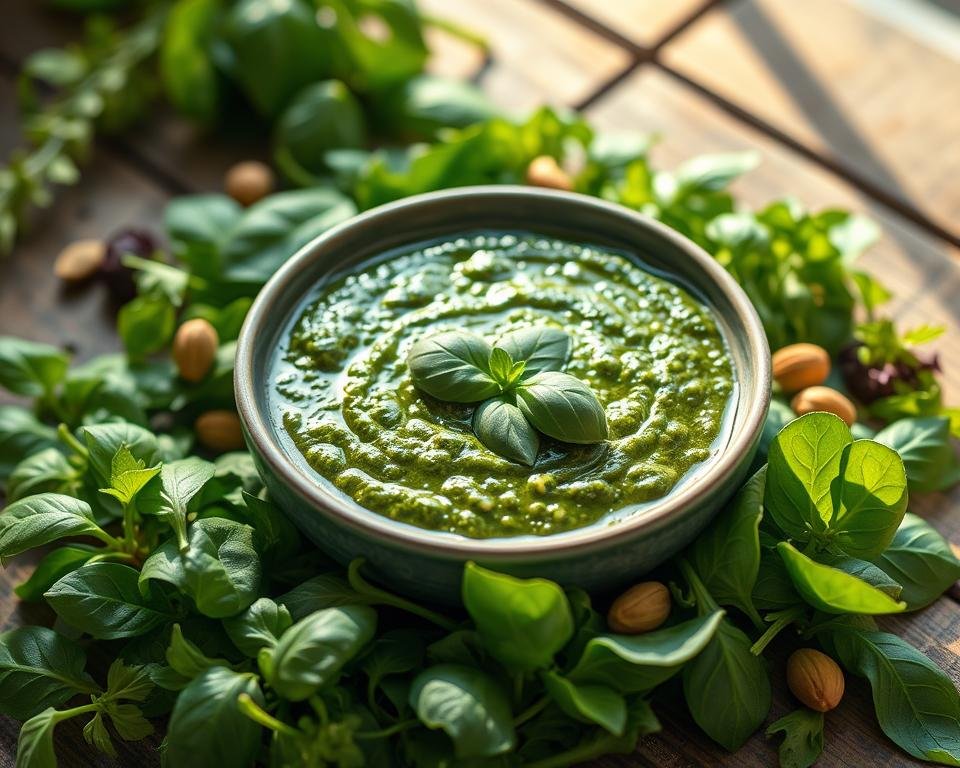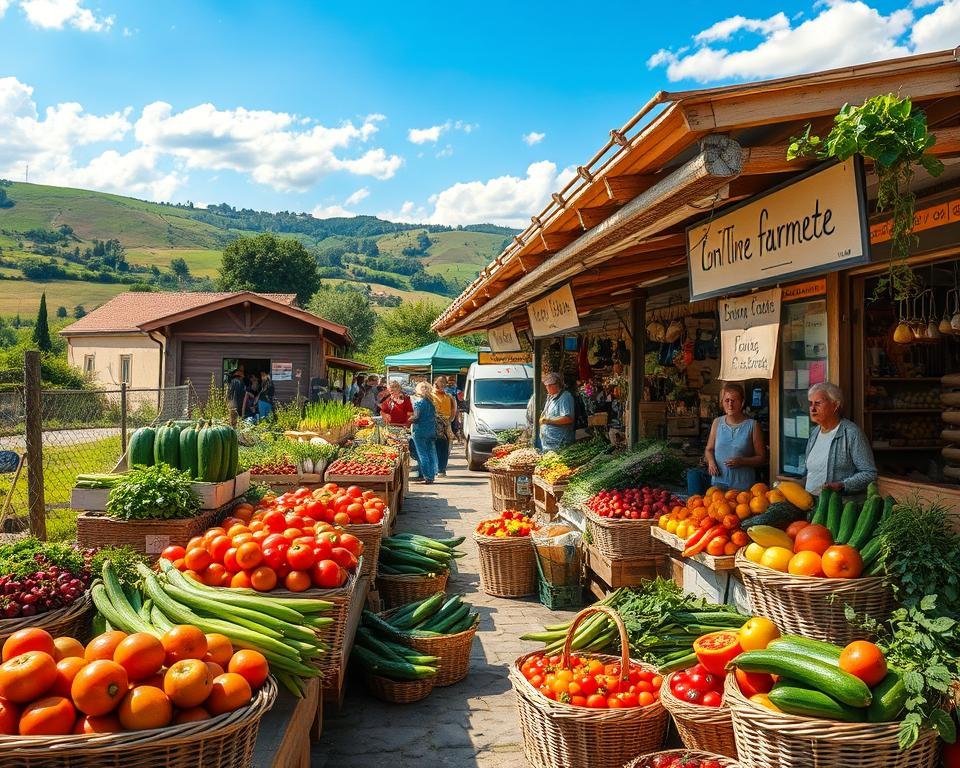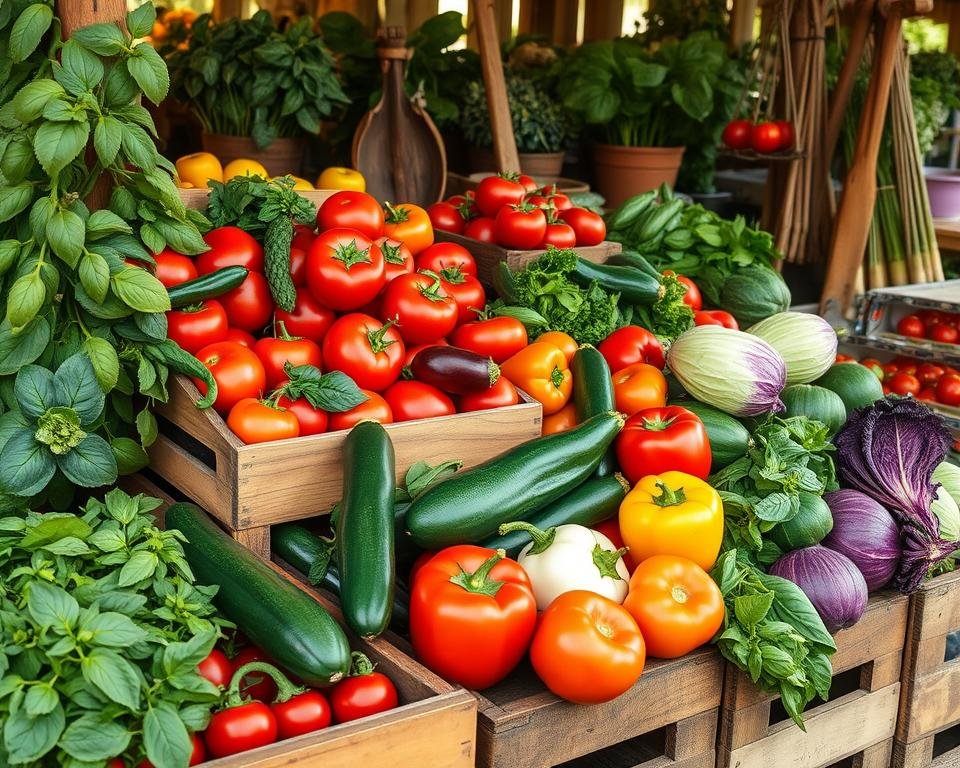Imagine sitting in a Tuscan kitchen, surrounded by the smell of roasted veggies and fresh herbs. Italian cuisine takes you to a world where fresh vegetables and farm produce are the stars. As a fan of the Mediterranean diet, I’m excited to share how to make authentic Italian veggie recipes at home.
Let’s explore the seasons through Italian farm-to-table cooking. We’ll see how simple ingredients become delicious meals. For example, a Caesar Salad can be made in just 30 minutes. Tomatoes are packed with Vitamins A, C, and K.
This guide is for everyone, whether you’re an experienced cook or just starting out. You’ll learn about sustainable cooking, the benefits of local ingredients, and how to make healthy, tasty dishes. So, get ready to make your table taste like Italy!
Understanding the Farm-to-Table Movement in Italian Cuisine
Italian cooking has always valued the farm-to-table approach. This tradition is deeply rooted in Italy’s rich history. It celebrates local foods and sustainable farming, giving you a real taste of Italy’s varied regions.
Origins of Italian Farm-to-Table Cooking
The farm-to-table idea in Italy goes back centuries. Each area has its own special dishes. The “chilometro zero” idea is key, focusing on local food to keep it fresh and reduce travel.
Benefits of Seasonal Vegetable Selection
Seasonal eating is key in Italian cooking. Picking vegetables when they’re at their best gives you better taste and nutrition. From juicy tomatoes in Campania to artichokes in Rome, every season offers its own treats.
Sustainable Practices in Modern Italian Cooking
Today, Italian chefs and farmers are using green farming methods. They’re keeping traditions alive while protecting the planet. Organic and biodynamic farming are becoming more common, helping Italy’s culinary legacy last.
| Region | Specialty | Sustainable Practice |
|---|---|---|
| Tuscany | Organic olive oil | Small-scale, traditional harvesting |
| Piedmont | Truffles | Controlled foraging |
| Puglia | Fresh vegetables | Crop rotation |
By following these values, you get to truly enjoy Italian food. You support local farmers and taste the real flavors of each area.
Essential Italian Pantry Ingredients for Vegetable Dishes
Having the right Italian ingredients in your pantry can make your vegetable dishes amazing. Extra virgin olive oil is key in Italian cooking. It adds a rich flavor to salads, pasta, and dips. For cooking at moderate temperatures, use virgin olive oil.
Italian herbs are vital for authentic flavors. Fresh basil is great in salads and as a pasta garnish. Dried oregano, rosemary, and thyme add depth to sauces and soups. Garlic makes tomato-based sauces and seafood pastas taste better.
Balsamic vinegar brings a tangy sweetness to dressings and marinades. Canned tomatoes, especially San Marzano, are the base for many Italian sauces. Parmigiano-Reggiano cheese adds a nutty flavor to pasta dishes and risottos.
| Ingredient | Use | Flavor Profile |
|---|---|---|
| Extra Virgin Olive Oil | Finishing dishes, salad dressings | Rich, fruity |
| Balsamic Vinegar | Marinades, dressings | Sweet, tangy |
| Parmigiano-Reggiano | Grating over pasta, risotto | Nutty, savory |
Remember to have pantry staples like dried pasta, arborio rice for risotto, and canned legumes for soups. With these essentials, you’re set to make tasty Italian vegetable dishes anytime.
Spring Favorites: Italian Veggies Recipe Collection
Spring brings a bounty of fresh produce, perfect for Italian-inspired dishes. Let’s explore some delicious recipes that showcase the season’s best vegetables.
Fresh Basil Pesto with Spring Greens
Basil pesto is a classic Italian sauce that shines with spring greens. Blend basil, garlic, pine nuts, olive oil, and Parmesan cheese for a vibrant spread. Mix it with pasta or use it as a dip for raw veggies. This versatile sauce packs 15 grams of protein and 13 grams of healthy fats per serving.

Springtime Mixed Greens with Cured Tomatoes
Create a refreshing salad with mixed greens and cured tomatoes. Toss 15 halved cherry tomatoes with baby spinach, arugula, and radicchio. Drizzle with a light vinaigrette and sprinkle 1/2 cup of grated Parmesan cheese. This nutrient-rich salad offers 6 grams of fiber and only 185 milligrams of sodium per serving.
Classic Spring Vegetable Frittata
A frittata is a perfect way to showcase spring produce. Whisk eggs with sautéed asparagus, peas, and spring onions. Bake at 450°F for 20-25 minutes until golden and set. This protein-packed dish contains 455 calories per serving and is both nut-free and vegetarian-friendly.
| Recipe | Prep Time | Cook Time | Servings |
|---|---|---|---|
| Basil Pesto | 10 minutes | N/A | 4 |
| Mixed Greens Salad | 15 minutes | N/A | 4 |
| Spring Frittata | 15 minutes | 25 minutes | 6 |
These spring-inspired Italian recipes celebrate the season’s freshest ingredients. They’re simple to prepare and packed with nutrients, making them perfect for any meal.
Summer Garden-to-Table Specialties
Italian food is at its best in summer, thanks to fresh garden produce. Ciambotta and Pasta Primavera are two dishes that highlight summer’s flavors. They use tomatoes, zucchini, eggplant, and fresh herbs.
Ciambotta is a Southern Italian stew made with eggplant, zucchini, and tomatoes. It’s great because you can adjust the cooking time. Cook it briefly for a stew or longer for a thicker spread. It’s perfect for appetizers or snacks.
Pasta Primavera is loved by many, with a 4.98 out of 5 rating. It’s quick to make, ready in 30 minutes, and serves four. It’s filled with cherry tomatoes, squash, zucchini, and asparagus. Fresh basil and tarragon add a bright, herbal taste.
| Dish | Key Ingredients | Cooking Time | Serving Suggestion |
|---|---|---|---|
| Ciambotta | Eggplant, zucchini, tomatoes, peppers, mushrooms | Varies (30-60 minutes) | Appetizer or main dish |
| Pasta Primavera | Penne pasta, cherry tomatoes, squash, zucchini, asparagus | 20 minutes | Main course |
Both dishes celebrate the farm-to-table movement, letting you enjoy summer’s best. Fresh ingredients are crucial. Visit your local farmers’ market for the ripest tomatoes and freshest vegetables for these Italian summer dishes.
Traditional Fall Italian Vegetable Dishes
As autumn leaves fall, Italian kitchens come alive with the flavors of seasonal produce. Fall brings a bounty of hearty vegetables perfect for comforting dishes. Let’s explore some classic Italian recipes that showcase the best of autumn produce.
Roasted Brussels Sprouts with Italian Herbs
Brussels sprouts shine in this simple yet flavorful dish. Toss halved sprouts with olive oil, garlic, and Italian herbs. Roast at 400°F for 25 minutes until crispy outside and tender inside. The result? A perfect blend of earthy and savory notes.
Pumpkin Risotto alla Italiana
Pumpkin risotto is a fall favorite in Italy. Creamy Arborio rice meets sweet, roasted pumpkin in this comforting dish. Sauté onions and rice, add white wine and broth gradually. Stir in pumpkin puree and finish with Parmesan cheese for a luxurious texture.
Caramelized Root Vegetables
Root vegetables take center stage in this rustic Italian side dish. Carrots, parsnips, and sweet potatoes are cut into chunks, tossed with olive oil and herbs, then roasted until caramelized. The natural sugars in these vegetables create a delightful sweetness.
| Dish | Prep Time | Cook Time | Servings | Calories per Serving |
|---|---|---|---|---|
| Roasted Brussels Sprouts | 10 minutes | 25 minutes | 4 | 180 kcal |
| Pumpkin Risotto | 15 minutes | 30 minutes | 4-6 | 300 kcal |
| Caramelized Root Vegetables | 15 minutes | 30 minutes | 4-6 | 200 kcal |
These traditional fall Italian vegetable dishes celebrate the rich flavors of autumn produce. From Brussels sprouts to pumpkin risotto and root vegetables, each recipe offers a unique way to enjoy the season’s bounty. Try these dishes to bring a taste of Italy to your fall table.
Hearty Winter Vegetarian Italian Favorites
Winter makes us crave warm, comforting meals. Italian cuisine has many vegetarian dishes great for cold nights. These recipes use winter vegetables in hearty soups and stews that warm your soul.
Minestrone is a classic Italian winter dish. It’s a thick vegetable soup with carrots, celery, onions, and beans. Add seasonal greens like kale or Swiss chard. Top it with Parmesan cheese for a cozy meal.
Ribollita is another Tuscan favorite. It’s a bread soup with cannellini beans, cabbage, and day-old bread in a tomato broth. It’s a comforting dish made with simple ingredients.
Zuppa di farro is a twist on traditional soup. It mixes farro with winter squash and root vegetables. This soup is both filling and healthy.
| Recipe | Calories per Serving | Prep Time | Cook Time |
|---|---|---|---|
| Minestrone | 104 | 15 minutes | 30 minutes |
| Ribollita | 297 | 20 minutes | 40 minutes |
| Zuppa di Farro | 303 | 25 minutes | 35 minutes |
These Italian vegetarian dishes warm you up and give you important nutrients. They’re full of fiber, vitamins, and minerals from winter veggies. Plus, they’re great for making in big batches, perfect for meal prep or feeding a group.
Italian Cooking Techniques for Perfect Veggie Preparation
Italian cuisine is known for its amazing veggie dishes. It uses techniques like blanching, roasting, and seasoning. These methods help make veggies taste great and look appealing.
Blanching and Roasting Methods
Blanching keeps veggies fresh and vibrant. Just briefly boil them, then cool them down in ice water. For roasting, heat your oven to 400°F. Mix veggies with olive oil and spread them on baking sheets. Roast for 30-40 minutes until they’re tender and lightly browned.
Proper Seasoning Techniques
Seasoning is crucial for tasty veggies. Use a mix of dried herbs like oregano, basil, rosemary, and thyme. Salt is important too. For a Mediterranean flavor, add fresh rosemary or try sage or bay leaves.
Al Dente Vegetable Cooking
Cooking veggies al dente keeps them crunchy and full of nutrients. It means they should still have a bit of firmness. Cook them until they’re just tender but still firm to the bite.
| Vegetable | Blanching Time | Roasting Time | Al Dente Time |
|---|---|---|---|
| Zucchini | 1-2 minutes | 15-20 minutes | 3-5 minutes |
| Bell Peppers | 2-3 minutes | 20-25 minutes | 4-6 minutes |
| Carrots | 3-4 minutes | 25-30 minutes | 5-7 minutes |
| Broccoli | 2-3 minutes | 15-20 minutes | 3-5 minutes |
Creating Balanced Italian Vegetable Platters
Making the perfect antipasti platter is like creating a work of art. It combines the lively tastes of Italian food. A balanced vegetable platter is a treat for both the eyes and taste buds. It highlights the freshest seasonal produce.
To start, base your platter on grilled vegetables. This is the heart of your Italian appetizer experience.
When putting together your platter, mix colors, textures, and tastes. Add roasted veggies like zucchini, baby potatoes, mushrooms, and sweet Campari tomatoes. Roast them at 410-450°F, using 1/4 cup of good extra virgin olive oil. This makes them crispy on the outside and soft inside.
- Cut vegetables into similar sizes for even cooking
- Roast potatoes for 10 minutes before adding other veggies
- Use a dark baking pan for better browning
- Avoid overcrowding the pan to maintain texture
Pair your roasted veggies with marinated olives, cured meats, and Italian cheeses. This mix of flavors is a true taste of Italy. The secret to a great platter is its variety and how it looks. It invites everyone to try and enjoy each part.
“A well-crafted antipasti platter is a celebration of Italian culinary traditions, bringing together the simplicity of fresh ingredients and the complexity of balanced flavors.”
If you want to keep your platter’s flavors, try making giardiniera. This Italian pickled veggie mix is great for keeping your antipasti fresh. It makes 4-6 jars and needs 2 1/2 pounds of veggies, 4 cups of white wine vinegar, and spices like bay leaves and cloves.
Tips for Sourcing Local Ingredients Italian-Style
Try the Italian way of cooking by using ingredients from local farmers markets. It makes food taste better and helps the local economy. Plus, it’s good for the planet.
Building Relationships with Local Farmers
Meet the farmers at your local markets. Ask them about how they grow their food and what’s in season. These friendships can give you the best tips and maybe even discounts.

Selecting the Freshest Produce
Choose vegetables by using your senses. Look for bright colors, firm textures, and smells that make you hungry. Even imperfect veggies can taste amazing. Fresh, local produce is always the best choice.
Seasonal Market Shopping Guide
Make a guide to shop for farm-fresh food all year. In spring, find tender greens and asparagus. Summer has tomatoes and zucchini. Fall brings squash and root veggies, and winter has hearty greens and citrus.
- Spring: Artichokes, peas, fava beans
- Summer: Eggplants, peppers, basil
- Fall: Pumpkins, mushrooms, radicchio
- Winter: Kale, fennel, citrus fruits
By shopping seasonally like the Italians do, you’ll get tastier meals. You’ll also help local farmers and the environment. In Italy, eating what’s in season is a big part of their culture. It shows their love for quality and community.
Health Benefits of Mediterranean Vegetable Dishes
Try Italian vegetable dishes for great health benefits. The Mediterranean diet, inspired by Southern Europe, is tasty and good for your heart and life. Let’s look at a classic recipe that shows these benefits.
Mediterranean Roasted Vegetables highlight the diet’s focus on plants. This dish mixes tomatoes, red onion, bell peppers, zucchini, and yellow squash. It’s seasoned with thyme, oregano, garlic powder, and cumin, making it both delicious and healthy.
Here’s a breakdown of this heart-healthy recipe:
| Aspect | Details |
|---|---|
| Servings | 10 |
| Prep Time | 10 minutes |
| Cook Time | 20 minutes |
| Calories per Serving | 66 |
| Carbohydrates | 6g |
| Protein | 1g |
| Fat | 5g |
The Mediterranean diet is famous for its olive oil and vegetables. These foods are full of antioxidants and healthy fats. They help keep your heart healthy and might lower disease risks like dementia.
Adding Italian vegetable dishes to your meals is more than just a taste treat. It’s a choice for a lifestyle that values fresh, whole foods. This lifestyle is linked to many health benefits. It’s a tasty way to care for your body and maybe live longer.
Conclusion
Embracing Italian vegetable recipes and the farm-to-table lifestyle can change how you cook. Seasonal cooking opens up a world of flavors that shift with the seasons. Italian cuisine brings a variety of tastes and textures, from spring greens to winter roots.
Using fresh, local ingredients is key to authentic Italian dishes. Exploring vegetable-based main dishes makes meals more varied and healthy. Whether it’s a simple salad or a complex dish, farm-to-table cooking makes your food both nutritious and tasty.
Don’t be shy to try new things in Italian vegetable recipes. Swap ingredients with what’s in season or at your local market. Italian cooking is all about simplicity and flexibility. So, put on your apron, visit your farmers’ market, and start making your own Italian dishes today!
FAQ
What is the farm-to-table movement in Italian cuisine?
The farm-to-table movement in Italian cuisine focuses on using fresh, local ingredients. It’s based on traditional Italian cooking and supports sustainable farming. This approach enhances flavors and helps local farmers.
How can I stock my pantry with essential Italian ingredients?
Stock your pantry with Italian essentials like extra virgin olive oil and balsamic vinegar. Also, include Parmigiano-Reggiano cheese. Don’t forget herbs and spices like basil and oregano to add flavor to your dishes.
What are some popular Italian spring vegetable recipes?
Popular spring recipes include fresh basil pesto with greens and a springtime mixed greens salad. You can also try a classic spring vegetable frittata with asparagus and peas.
How can I incorporate summer vegetables into Italian dishes?
Use summer vegetables in dishes like Eggplant Caponata and Layered Ratatouille. You can also add fresh tomatoes, zucchini, and herbs to summer recipes. These dishes highlight the summer garden’s bounty.
What are some traditional Italian fall vegetable dishes?
Traditional fall dishes include roasted Brussels sprouts with herbs and creamy pumpkin risotto. Caramelized root vegetables are also a favorite. These dishes celebrate autumn’s rich flavors.
How can I prepare hearty Italian vegetarian dishes for winter?
For winter, make warming soups and stews with winter vegetables like kale and squash. These dishes bring comfort and showcase Italian winter cuisine’s rich flavors.
What are some essential Italian cooking techniques for vegetables?
Key techniques include blanching and roasting vegetables. Seasoning and cooking vegetables al dente are also important. These methods enhance texture and taste.
How can I create a balanced Italian vegetable platter?
Create a balanced platter by combining vegetables, cheeses, and olives. Marinate and present the vegetables in an authentic Italian style. Focus on variety and visual appeal.
What tips can you offer for sourcing local ingredients Italian-style?
Build relationships with local farmers and learn to select fresh produce at markets. Create a seasonal shopping guide. This ensures access to the best ingredients all year.
What are the health benefits of Mediterranean-style vegetable dishes?
Mediterranean-style dishes improve heart health and longevity. The Mediterranean diet, rich in vegetables and olive oil, boosts overall well-being and nutrition.

